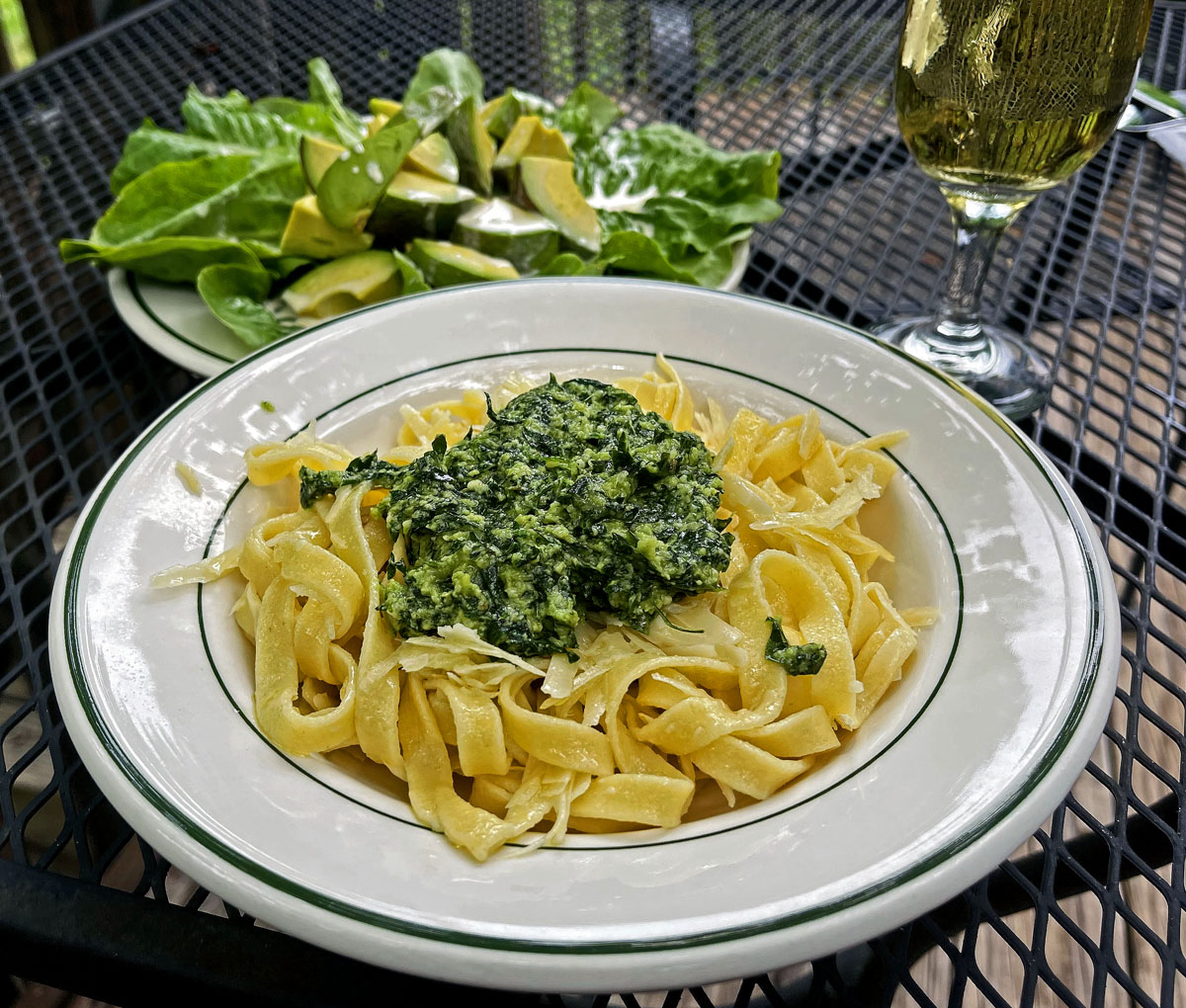
Homemade tagliatelle with basil-parsley pesto. The basil, parsley, and lettuce came from my garden. The pesto was made with a mortar and pestle.
When I posted last week about working on my Italian cooking (“A summer project: Italian cooking,” June 2), I was not thinking about pasta — honest. I was thinking about how to make the most of the summer vegetables from my garden.
But as I read more and more of Elizabeth David’s Italian Food, I realized that pasta is part of the deal in Italian cuisine. So I needed a pasta plan — including figuring out how not to eat too much of it.
It was easy to see that a pasta machine would be necessary. I am pretty sure that I will never, ever, be able to make pasta with a rolling pin. So, when I was grocery shopping on Tuesday, I stopped by the Williams Sonoma in Winston-Salem and bought an Imperia (made in Italy!) pasta machine, $80. This is a hand-cranked machine. Williams Sonoma also has attachments for KitchenAid mixers. But the attachments are much more expensive than the hand-cranked machine, and I reasoned that a pasta machine driven by such a high-powered motor would be a very high-powered way to make a very big mess.
With the hand-cranked machine, at least, the mess is much less than I feared. I was afraid of a sticky mess. But instead it was a mere floury mess. If you’re used to handling dough, your second batch of pasta will be excellent. I won’t presume to give any instructions here, because I’m just a novice. But there are many videos on YouTube about how to make pasta at home.
Amazon also has the Imperia machine, for less, naturally, than I paid at Williams Sonoma. It’s a heavy little thing. And it’s entirely practical, not at all a use-it-once kitchen gadget.
I do have one warning. Most recipes for pasta will make an outrageous amount of pasta, enough to feed a family of ten, to require a 40-gallon cauldron for boiling, to keep you turning a crank for half a day, and to run out of places to hang pasta. If you’re cooking for an old-fashioned Catholic family, I understand. But since I cook only for myself and for the possum who makes nightly visits to my backyard, even a one-egg batch of pasta is more than twice as much as I can eat. My possum will eat Italian tonight.
A thought that helped me overcome my resistance to making something as high-calorie as pasta is that pasta skills (and a pasta machine) also will assist with egg dumplings, which would make a fine winter comfort food. Also, the method of making Asian noodles can’t be that different from making Italian pasta.
I’m probably the last California-influenced cook to start making pasta. There are two skills involved, I would say: How to make the pasta (easy); and how not to make too much of it (hard). The real technical challenge with homemade pasta, I would say, is making no more of it than you ought to eat.

You know you can freeze leftover pasta and use it for another day. Or, just roll out the dough you want and seal the rest of the unrolled dough in plastic to process for the next meal. Happy pasta adventuring. It’s great stuff.
Hi, Karren: Thank you… I will freeze some of the dough next time. 🙂 Do you make filled pasta?
I have made filled pasta. Actually, I taught a pasta class in which we made the basic dough, then cut it into noodles, wide and thin, and also formed ravioli, tortellini, wontons and pierogi. We rolled out most by hand, but the machine came in handy to get the dough rolled out evenly. As a group, we each made something different, then made sauce and tasted all our creations. It was a fun class, with lots of good tastes. Pasta is so versatile, and can be changed into many different dishes. Happy adventuring!
Karren: Nice! If I may pester you with one more question… Did you make a different sort of dough for the wontons or pierogi?
No problem, pester away. Nope, it was all the same batch of dough. Each person in the class made a standard two egg batch of dough, and then rolled it to the desired thickness by hand, then formed into whatever they were working on. If I had your email address, I could send you the recipe handout I made for the class.
Funny thing. I locally sourced free-range eggs from a friend, and set them in a big bowl in the middle of our working space. Beautiful, all sizes and colors and everyone loved them. The first class went great, all the dough was supple and formed well. When the evening class made theirs, they were all dry and just wouldn’t work well. I finally realized that the morning class chose the larger eggs, leaving the smaller ones for the evening class and there just wasn’t enough moisture in the smaller eggs to make a good batch. We had to add water to make the evening class pasta workable. It surprised us all that the size of the egg made that much difference.